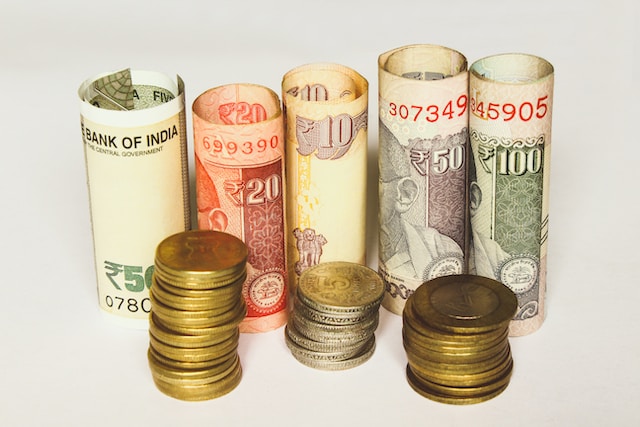In recent years, there has been a notable shift in the global financial landscape, with the Indian Rupee emerging as a potential contender to replace the long-standing dominance of the US Dollar.
This blog post aims to delve into the reasons behind this shift and shed light on how the Indian Rupee is making strides toward becoming a global currency.
By exploring the dynamics of the Rupee versus the Dollar, examining the factors driving the Indian Rupee’s ascent, and analyzing the global acceptance of the Rupee, we can gain a deeper understanding of this significant financial trend.
The Rise of the Indian Rupee:

The Indian Rupee, as the official currency of India, has witnessed a remarkable journey in recent years. As one of the world’s fastest-growing economies, India has gained increasing prominence on the global stage, bolstering the position of its currency.
The Rupee has experienced steady appreciation against the US Dollar, contributing to its growing recognition as a formidable global currency.
Rupee VS Dollar: A Comparative Analysis:

When comparing the Indian Rupee to the US Dollar, it is crucial to examine various factors that influence their exchange rates. Economic indicators, geopolitical developments, and monetary policies play pivotal roles in determining the relative strength of these currencies.
While the Dollar has enjoyed a long-standing reign as the world’s primary reserve currency, the Rupee’s gradual rise indicates a potential shift in this dynamic.
Indian Rupee Replacing Dollar: Factors Driving the Change:

Several factors have been instrumental in propelling the Indian Rupee towards replacing the Dollar as a global currency.
Firstly, India’s robust economic growth and increasing influence in international trade have elevated the Rupee’s status.
Additionally, the Indian government’s initiatives to promote financial reforms, attract foreign investments, and strengthen economic ties with other nations have bolstered confidence in the Rupee’s stability and reliability.
Global Acceptance of the Indian Rupee:

The acceptance of a currency on the global stage relies heavily on its usability and recognition. In recent years, the Indian Rupee has made significant strides in this aspect.
The growing number of countries accepting the Rupee for trade, investment, and settlement purposes reflects its increasing acceptance and credibility.
Moreover, international financial institutions and central banks have been diversifying their reserves by including the Rupee, further solidifying its global standing.
The Role of Technology in Facilitating the Shift:

Technological advancements have played a crucial role in facilitating the global acceptance of the Indian Rupee.
Digital payment systems, blockchain technology, and cross-border remittance platforms have made transactions more seamless and efficient.
As India continues to lead the way in digital innovation, the ease of transacting in Rupees on a global scale becomes more attainable.
-
Digital Payment Systems: Revolutionizing Financial Transactions
- Introduction to digital payment systems
- How digital payment systems have transformed financial transactions
- The impact of digital wallets and mobile banking apps on the adoption of the Indian Rupee
- Examples of successful digital payment systems in India and their contribution to the global acceptance of the Rupee
-
Blockchain Technology: Enhancing Security and Transparency
- Understanding blockchain technology and its relevance to global currency adoption
- How blockchain technology can enhance the security and transparency of Rupee-based transactions
- Exploring blockchain-based solutions for cross-border remittances and international trade in Rupees
- Potential challenges and opportunities for integrating blockchain technology with the Indian Rupee
-
Cross-Border Remittance Platforms: Simplifying International Money Transfers
- The importance of efficient cross-border remittance platforms in global currency adoption
- Examining the role of fintech companies in facilitating Rupee-based remittances
- Benefits and challenges of using cross-border remittance platforms for Rupee transactions
- Case studies of successful cross-border remittance platforms and their impact on the global acceptance of the Indian Rupee
-
Leveraging Financial Technology: Opportunities for Innovation and Growth
- Exploring the intersection of financial technology (fintech) and the Indian Rupee’s global adoption
- Opportunities for fintech companies to innovate and create solutions that promote the use of the Rupee as a global currency
- Government Initiatives and regulatory frameworks supporting fintech innovation in India
- Collaborative efforts between financial institutions, and technology firms. And the government to drive the global acceptance of the Rupee through fintech advancements
Bottom Line
The rise of the Indian Rupee as a potential global currency marks a significant shift in the international financial landscape. As India’s economic influence continues to grow, the Rupee’s prominence strengthens, challenging the long-standing dominance of the US Dollar.
Factors such as the comparative analysis of the Rupee vs Dollar, the Indian government’s economic reforms, and the increasing global acceptance of the Rupee all contribute to this transformation.
As we move forward, it is crucial to monitor this evolving trend and its implications for global finance.
Ready to explore the changing dynamics of global currencies? Visit CurrencyVeda for in-depth insights, analysis, and expert guidance on the Indian Rupee as a global currency. Empower your financial knowledge today!
What factors have contributed to the rising prominence of the Indian Rupee as a global currency?
Factors such as India's robust economic growth, financial reforms, increasing international trade, and strengthening economic ties have bolstered the Rupee's prominence.
How does the Indian Rupee challenge the dominance of the US Dollar?
The Indian Rupee challenges the Dollar's dominance through its steady appreciation, growing acceptance for international transactions, and inclusion in global reserves and trade settlements.
What role does technology play in facilitating the shift towards the Indian Rupee as a global currency?
Technology plays a vital role by enabling digital payment systems, blockchain technology for secure transactions, and cross-border remittance platforms, making the Rupee more accessible and efficient on a global scale.
What are the implications of the Indian Rupee's rising prominence as a global currency?
The implications include reduced dependence on the US Dollar, increased economic influence for India, potential benefits for trade and investment, and a shift in the global financial landscape.
How does the global acceptance of the Indian Rupee affect individuals and businesses?
Individuals and businesses can benefit from easier cross-border transactions, reduced exchange rate risks, increased trade opportunities, and enhanced financial stability with the growing acceptance of the Rupee as a global currency.








